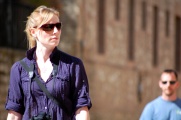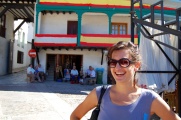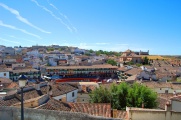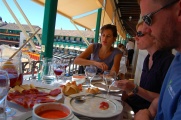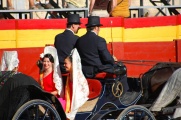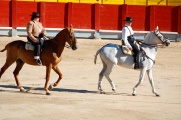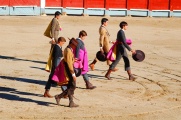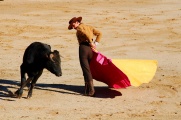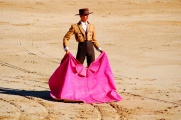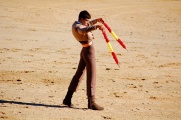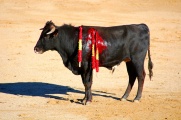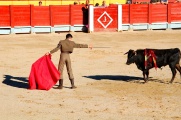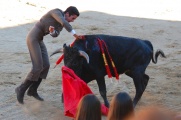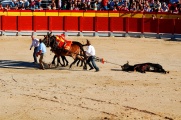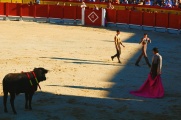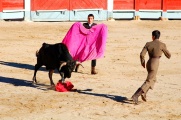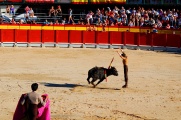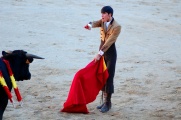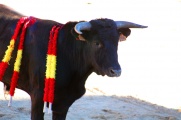Chinchón
![]() the recordings below are mine.
the recordings below are mine.
Chinchón is a typical castillian village nearby Madrid (50km), once home of Goya who left in the church of Nuestra Señora de la Asunción an eponymous masterpiece, praised as a fine sample of his early work. The village produces a famous brand of anís (anisette) exceptionally potent in alcohol content, 74%, said to be one of the strongest in the world, not forbidden in respect of the cultural heritage. Chinchón's elliptical plaza mayor makes a stupendous arena for another culturally protected heritage, the corrida de toros (bullfighting).
It is a nice place to visit if you are in Spain, it should give you a fair taste of the real thing. We have been there in September (2012) with visiting friends (Alaine & Dave, recently wed) and another, then local, friend, Maria. We also had the charge for the day of a little dog, Tizón.
The highlight was supposed to be culinary, tasting cabrito (goat), but we were misinformed and the local speciality is, in fact, cordero (lamb), which was equally fine; it could also have been cochinillo (suckling pig), any one of these three is a pillar of the castillian food and you've done most of what you should have once you got that experience right.
We realized, however, that an important local festival was taking place later in the day: la Novillada. A lunch in Spain is, during the week-end, taking most of the day, so we would be there just fine for whatever it was. For most of the time we assumed it was some sort of play with young bulls or cows, dodging and leaping, running around, possibly involving the public and, of course, with no bloodshed. This is in fact called Capea, with young, harmless bulls involving amateurs. In France, this is called Course Landaise and is a favourite of children on TV.
It quickly turned out, however, that the Novillada is a real bullfight. It is called so because both bulls and toreros are young and inexperienced. There is not the horse part to weaken the giant beast that no man could contend unaided. There is a morbid parallel of the Spanish language to designate both the young bulls (novillos) and the young men (novilleros). The novillo will die and the novillero will become a matador.
When discussing Spanish culture, it is commonplace to raise the topic of the corrida, although you may find most Spanish people are now estranged from it. It is still popular in some areas and still commonly retransmitted on TV in some bars. What is it for the rest of us? For me it is a strange mixture of art and barbarism, of culture and horror, of sophistication and atrocity. Should it be banned? Should it even be witnessed?
We wouldn't have brought our friends so light-heartedly to this spectacle of blades and blood. Maria, the day before, had tidied up together flamenco, tapas, el retiro and the breakfast with chocolate and churros. Still we thought there was a lot left before it came to this. But here we were, it was hardly possible to even avoid it. Our terrace had a vantage point on the arena, the entry was free, the whole village—toddlers and children included—seemed to be in the tribune. Even if strongly against the practice itself, in a small village of Spain, you might just find it happening right before your eyes. Of course you can leave. That's what we did, but to be sure, at least innocent of the premeditation, we decided to see for ourselves.
Till the very start we even doubted we would witness anything that could be unsettling. Someone in front of us, looking at the shadows undressing the benches, commented: "after the first three toros, we can move over there". So our doubts were getting stronger... but until you see blood spilt over, it remains quite a distance away from your mind, something that might be true not only in an arena.
And after the orchestra, the beauty queens, the horses and a few others parading around, there he comes, the toro.
It is really, truly a cruel thing to see. He's young (I'll say "he", not "it"), so he's playful. At the same time, it's hot, he's licking himself, he's looking for the shadow, he's looking at the people around, a lot of them, enticing, exhibiting their genitalia just like him, but shouting. He's turning his head at this one over there, then at this other one over there, with no malice, no anger, then he throws himself into the game. He's playing all right and it's beautiful at the same time, the colour, the sun, the sand, the cape floating and slashing, the young man whirling inside, dancing with a shadow.
They should leave it there.
But then comes the banderillero, the one with two sharp barbed sticks that he plunges with all the force of his chest recoiling from the shock into the bull's shoulders, making the first blood splatter and the Spanish flags all around the arena suddenly become of this same colour than the one that stains in copious quantity the bull's skin, darker than anything I have seen before.
There I could swear, you see the bull wondering what is going on.
It is excruciating to look at. At the same time, young children, with their parents, don't seem much affected by the sight, they question the grandfathers who explain the complicated protocol, who pass on the vocabulary, the very same which did not make it to Elena who was, a few hours before, oblivious of what a novillada is, although the whole folklore reached the previous generation. Her father, later in the evening, told me everything of the ritual, its order, its reason and meaning, without being, quite on the contrary, an aficionado. He's never been to a corrida himself. Should all Spanish people slowly forget about this decried, and rightly so, custom?
It is a poignant allegory of life, which is a mix of the wonderful with the horrible. We left after two toros, Elena was sick. Alaine was fine, she's seen tougher things in Texas. Dave, I believe, can't be disturbed by anything, he would have enjoyed it even if it would have been gladiators down there. But being a gentleman, he moved us out seeing that some of the ladies—and he was probably counting me in—were pale. Maria was rather disturbed but I think she could have stayed more. I definitely could have stayed more, although I was experiencing mainly negative feelings, of rage and injustice. I was also stunned by the visual impact of a murder taking place right in front of my eyes, and of all the contradictions, challenges, conflict, denial this was bringing forward. It was like reading an open book... I was feeling that, however disgracious, there was something deep and true about the human nature that was revealed in this way it found to show its primitive face. And it was something I wanted to see more of. I don't think I have exhausted the topic. But we left and maybe we will never return; it is not, again, something I would like to go on my own accord.
To make things worst in this particular instance, the bulls were young, small, not a massive mountain of sweating muscles. They looked almost harmless. And the inexperience of the toreros turned the execution into a dreadful, sadistic, vicious torturing of the cute, innocent, ingenuous animal. The first one had to stab the poor thing repeatedly. When he finally managed to engulf his sword entirely along the spine of the bull, the latter felt on his knees and gave up, merely waiting for the whole tragedy to end, though, rather than just falling on his side, he remained there standing up on whatever little fragment of force was left after all the stinging and the exhaustion, running after the silly, ugly parody of a Spanish face mocking him and infuriating him. Dignity in a slaughtered animal.
There is a knife to be plunged in his neck, to bring him down completely. The first bull was on his knees, in agony, and the guy in charge was butchering unsuccessfully the oozing head precessing with the eyes, all white, looking for something in the sky. When finally the knife touched something it had to, the heavy head collapsed along with the whole body, in a smoke of sand.
This, I felt, was murder. With little exaggeration. Look at the last photo of the series. 4331, maybe he even had a proper name. He had an expression, though, of misunderstanding, of incredulity, of disappointment. I don't know. The way he was looking back and forth, he seemed more humane than the mouths wide open shouting at him. I am only reading my own feelings in all this, no doubt. But isn't the rest of universe for this, to read ourselves in it?
I will leave it there with two other personal, much more powerful interpretations than mine. They are both in French with some Spanish. The first is the way an overly sentimental poet found to throw his remonstration at the face of humankind. The second is a deeper and merciless denunciation touching with bleeding words dancing on Spanish tunes like the bull on the arena, at our pathetic futility in all things, not only in murdering toros. If you don't speak French, you could learn it for the lyrics of this second song alone.
Tizón, maybe the most little thing to have trodden here.
[...] Civilization is only a very thin and easily broken veneer. I just hope we never have an apocalypse and experience first-hand what we can see so easily if we look just below the surface.
Kevin Clift
Links
- Chinchón on the Spanish Wikipedia.
